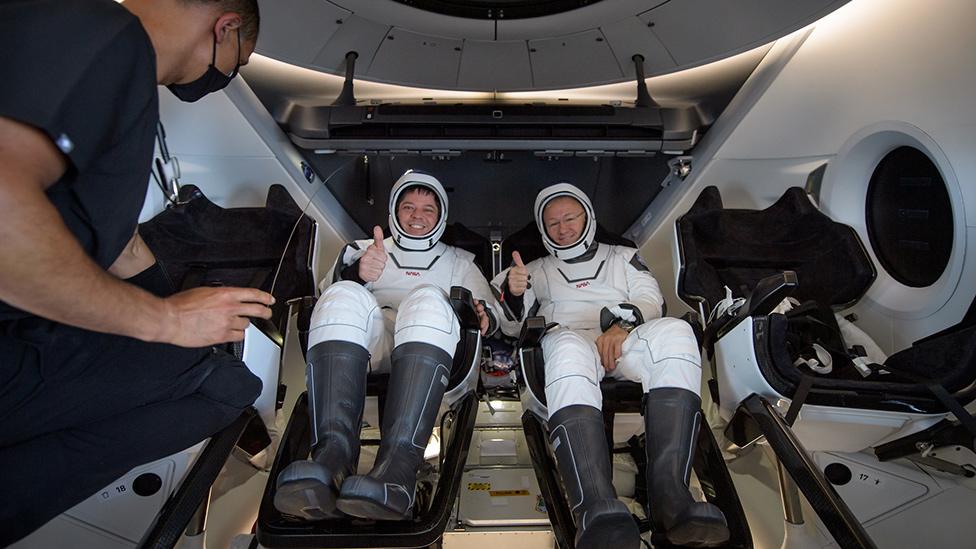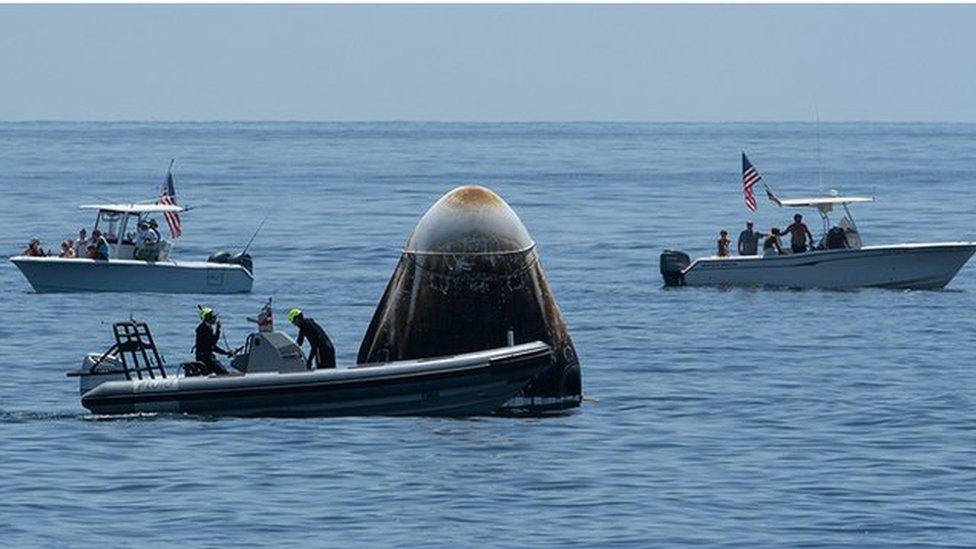SpaceX: Nasa crew describe rumbles and jolts of return to Earth
- Published
Bob Behnken describes jolts that were like being hit in the chair with a baseball bat
Astronauts Bob Behnken and Doug Hurley have described the rumbles, heat and jolts of returning from space in the Crew Dragon spacecraft on Sunday.
Behnken vividly described the clouds rushing by the window and jolts that were like being "hit in the back of the chair with a baseball bat".
But Hurley and Behnken said the spacecraft performed just as expected.
They splashed down in the Gulf of Mexico, ending the first commercial crewed mission to the space station.
"As we descended through the atmosphere, I personally was surprised at just how quickly events all transpired. It seemed like just a couple of minutes later, after the [de-orbit] burns were complete, we could look out the windows and see the clouds rushing by," he said at a news conference broadcast from Nasa's Johnson Space Center in Houston.

"Once we descended a little bit into the atmosphere, Dragon really came alive. It started to fire thrusters and keep us pointed in the appropriate direction. The atmosphere starts to make noise - you can hear that rumble outside the vehicle. And as the vehicle tries to control, you feel a little bit of that shimmy in your body.
"We could feel those small rolls and pitches and yaws - all those little motions were things we picked up on inside the vehicle."
As the spacecraft - named Endeavour by its crew - descended through the atmosphere, the rumbles increased in magnitude and the thrusters began to fire continuously. "I did record some audio but it doesn't sound like a machine, it sounds like an animal," said Behnken.
During the return from the International Space Station (ISS), the crew module has to separate from a section called the trunk, which has solar panels and heat-removal radiators.
"All the separation events, from the trunk separation through the parachute firings, were very much like getting hit in the back of the chair with a baseball bat," said Bob Behnken. "Pretty light for the trunk separation but with the parachutes it was a pretty significant jolt."

Behnken also described feeling some "warming" inside the capsule. He praised the engineers who worked on the Crew Dragon spacecraft: "I can't say enough about how well the SpaceX team trained us," he said.
Upon splashdown on Sunday, a flotilla of private boats approached the bobbing Dragon, which came down in the sea off Pensacola, Florida.
They were asked to leave amid concern over hazardous chemicals venting from the capsule's propulsion system.
"We certainly appreciate the folks wanting to participate in the event, but there are some safety aspects that - as the administrator [Nasa chief Jim Bridenstine] said - we'll have to take a look at, because it can't happen like it did before."

Private boats turned up to see the capsule
Hurley said they were not aware of the boats while they were sitting in the capsule because of the scorch marks over the windows. "You see it was daylight outside but very little else," he said.
But reflecting on the historic nature of the mission, Hurley said it "was one of the true honours of my entire life, but certainly my professional career".
Nasa is handing over the transport of astronauts to and from the ISS to private companies, namely SpaceX and Boeing. Since the retirement of the space shuttle in 2011, the United States has had no vehicle with which to launch astronauts from its soil.
In the intervening years, it has paid Russia tens of millions of dollars per seat to launch US crew members on the Soyuz vehicle.
During the last ever shuttle mission - STS-135 - in 2011, the crew left a US flag on the space station with the intention that the next crew to launch on a US vehicle return it to Earth. Nine years later, Hurley and Behnken have brought back the symbolic item, which also flew on the first shuttle mission in 1981.
Follow Paul on Twitter., external
"Thank you for flying SpaceX" - Doug Hurley and Bob Behnken return to Earth